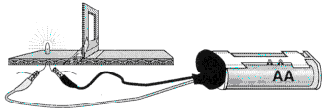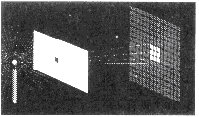
Why does the world gets dark so fast outside the circle of the campfire?
We all know that a light, such as a candle or a streetlight, looks dimmer the farther away from it we get. The question of how much dimmer it looks was answered a long time ago. Here's an easy way to repeat that discovery.
You need:
one sheet of Graph Paper
Cardboard or foamcore.
A file card
A Mini-Maglite™ flashlight.
A knife or scissors.
Procedure:
Unscrew the front reflector assembly of the Mini-Maglite™ to expose the bulb. The bulb on the MiniMaglite™ will come on and stay on when the reflector assembly is removed.
Now cut a hole in the file card the size of one square on the graph paper. Hold or mount the card 1 inch (2.5 cm) in front of the light source. The square of light made when the light shines through this hole will shine on the graph paper.

Keep the distance between the bulb and the card with the square hole constant at
1 inch (2.5 cm). Put the graph paper at different distances from the bulb, and count how many squares on the graph paper are lit at each distance. The results will be easier to understand if you make a table of "number of squares lit" versus "distance." Be sure to measure the distance from the bulb. Do this for at least 10 different distances.

Data:
Distance from the bulb (in.) # of squares illuminated
Data Analysis:
Make a graph of distance from the bulb (y-axis) vs. number of squares illuminated (x axis). Connect the points with a smooth curve. Describe the relationship between distance and area of illumination in words.
Questions (answer on a separate sheet of paper):
1. Using your graph, determine how many squares would be lit if the bulb were
a) 1 inch from the graph paper?
b) 2 inches from the graph paper?
c) 3 inches from the graph paper?
d) 10 inches from the graph paper?
2. Using your graph, how far away would the light be if
a) 4 squares were illuminated?
b) 16 squares were illuminated?
3. Two light sources of equal luminosity are shining on a screen. Light A is three times as far away as Light B. How much more area is covered on the screen by Light A?
4. How would you say the energy or brightness per square compares for Light A and Light B?
5. Using physics or astronomy books or the internet, look up the Inverse Square Law for light. What is the relationship between the apparent brightness of a star and the distance to the observer?